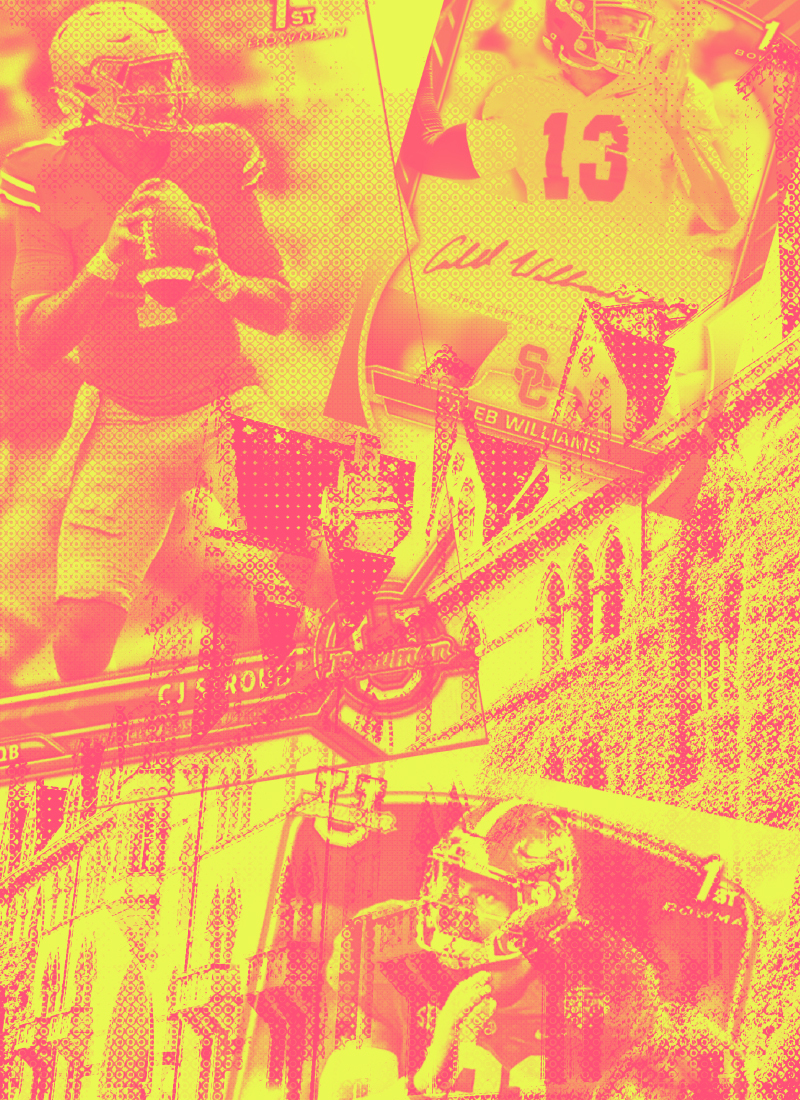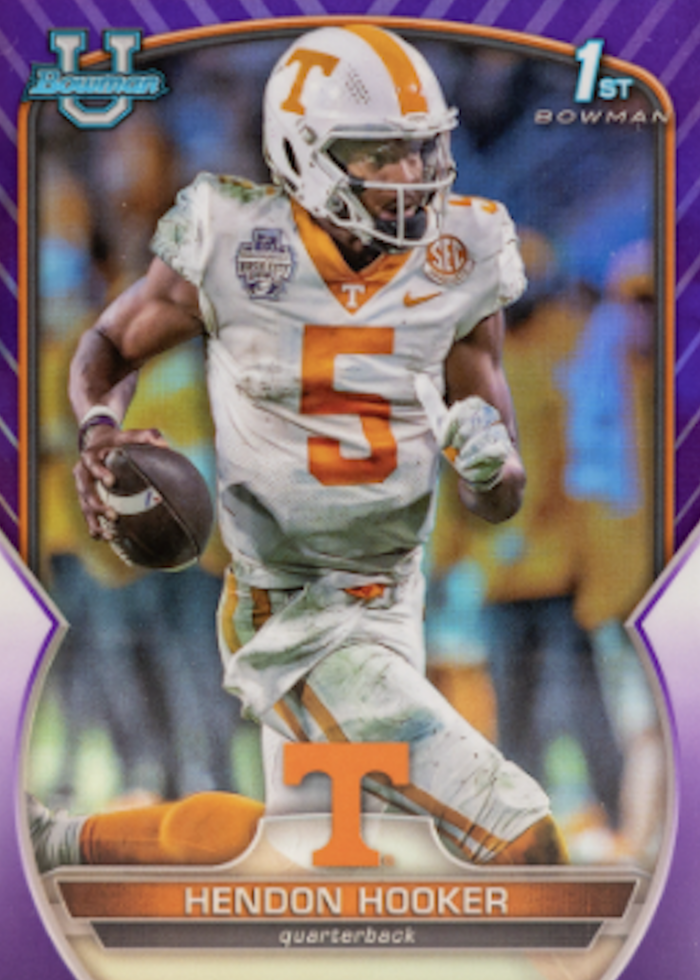
How Two Years of NIL Licensing Legwork Led to This Historic Launch
You could be the type to scour the message boards for transfer news in the offseason or start your gameday tailgate well before the sun comes up. Your whole closet could be dedicated to your favorite team. But no matter how much you love college football, you couldn’t really collect cards until last year.
The 2021-22 Bowman University Football set was disruptive, to be sure, but something was … off. The set featured top players like quarterback Kenny Pickett and wide receiver Chris Olave, but their uniforms were scrubbed of all school branding, and the card design was awkwardly devoid of any mention of the player’s team.
It was a big first step, but the lack of full licensing meant it wasn’t quite the complete package.
Enter 2022 Bowman U Chrome Football: the first licensed and complete card set to feature college athletes and their schools while they’re actually still in college. For college football fanatics, this presents an unprecedented opportunity to collect official cards of the stars they love before they become pros. This year’s set includes USC quarterback and Heisman winner Caleb Williams, along with top NFL Draft prospects like Ohio State quarterback C.J. Stroud and Alabama defensive end Will Anderson. (A complete checklist can be found here.)
“As a standalone set, this is the first of its kind,” said Ryan Hickey, Topps’ brand manager for college and NIL products. The all-chromium set features 100 of the best college football players in the country, with autographs available for each one of those featured.
But this groundbreaking card set didn’t appear magically overnight. It’s been in the works since the NCAA passed legislation allowing its student-athletes to profit off their name, image, and likeness (NIL) almost two years ago.
What’s NIL?
The NCAA governs all collegiate athletics. It remains steadfast in its belief that amateur student-athletes should not receive pay-for-play in the way that a professional receives a salary. Until recently, any student-athlete that received an “impermissible benefit” (say, a check to cover housing expenses or a free car) was in grave violation of NCAA rules upholding amateurism.
Because star running back Reggie Bush received benefits like these from a sports agent during his USC career, the Trojans had to vacate the 2004 BCS National Championship. Bush voluntarily forfeited his 2005 Heisman Trophy soon after.
But as college sports have gotten more lucrative, our understanding of amateur athletics has evolved. A landmark 2021 Supreme Court case led to a unanimous decision that the NCAA was violating antitrust law by restricting student-athlete compensation. (Even the bitterly divided SCOTUS voted 9-0 against the NCAA.) In the wake of that decision, the NCAA made a massive change to its rules: Student-athletes couldn’t be paid simply for playing, but they could profit from the use of their name, image, and likeness while at school. For the first time, players could use their platforms to sponsor products, appear in ads, and pursue other promotional activities, including trading cards.
Bowman Steps Up
Topps saw the opportunity that NIL legislation presented, and it went all-in on securing the licensing for college sports cards. Alex Holdstein, previously an assistant brand manager for Topps Baseball, became Topps’ talent licensing manager in the fall of 2021. He worked alongside Hickey and Renata Kukowski, the vice president of Fanatics College, to secure permission from universities and athletes to appear on the company’s cards.
While it might sound fairly straightforward, it’s not always so simple, especially for first-year products. Hickey says that it takes a while for all the stakeholders to get used to the process; there are usually some early hiccups, like a logo that uses the school’s secondary color instead of its primary color or a registered trademark symbol that’s missing.
“Once we get past the first year, we have a better understanding of the branding that the schools are looking for, and they’re better educated on our branding standards,” Hickey said. “It takes a good year to understand each other.”
One thing that made connecting with universities easier is that many of them are represented by licensing agencies. These agencies predate NIL and act on behalf of the schools for any commercial licensing needs — think of initiatives like merchandise and apparel. In all, Topps has acquired the rights to over 150 universities for future products.
Player Deals
When Topps first began making cards back in the 1950s, professional players’ unions didn’t exist in their modern form. As such, there wasn’t a mechanism for group licensing: in order to create trading cards, Topps executives had to go individually to each player and secure their agreements one by one.
The stories of that era have become the stuff of hobby lore: legendary Topps executive Sy Berger going into clubhouse locker rooms, giving out toasters and TVs to the players in exchange for their signatures. Willie Mays once wrote a letter to Topps complaining that the toaster he received was burning his toast and requesting a repair. This is how licensing deals got done back then.

Now, with college cards like Bowman U, the state of player licensing is something of a throwback to that early era. There aren’t any toasters involved — broken, repaired, or otherwise. But like professional baseball in the 1950s, there is no group licensing mechanism. The deals have to be negotiated one by one.
The biggest challenge is getting a foot in the door and starting the conversation. To do that, Holdstein must take extra care to make sure he’s talking with a legitimate representative, if not the player themselves. A few make it easy by putting a contact for business inquiries in their social media bios. Still, sometimes, Holdstein will send cold DMs to the player directly or go through a family member to secure a contract.
Then comes the question of autograph rates: how much should each player receive in compensation for their signature?
Kyle Maslan is an assistant brand manager at Topps and helped lead the autograph effort for 2022 Bowman U. Maslan says that determining autograph rates “is a mix of art and science.” It requires a delicate weighing of multiple factors. “You look at social media following, position, performance, projected draft position, and also where they go to school,” he said. “There’s a lot that goes into it.”
For someone like Caleb Williams, the fact that he plays for USC is a major factor. “USC is a big school with a huge fan base. They have a massive following, which hopefully means a big collector base.”
Maslan’s team also considers market pricing: if players have autographs that are already selling on the market, how much are they selling for?
“NIL is tricky because a lot of times, the player hasn’t signed before,” notes Maslan. “So there, you look for comparisons. Who is Caleb Williams similar to? Who is Jaxson Dart similar to? Who is Nick Singleton similar to?”
Historically, trading cards were the first endorsement deals that professional athletes signed. Back in the Sy Berger days, before athletes were the face of every major company and brand, trading cards were the only game in town. Now, in the new NIL world, trading cards like Bowman U are among the first endorsement deals for college players.
Yet for college athletes, signing a card deal is very different than, say, an endorsement deal for a local restaurant chain. Given the particular character of cards and collecting, the geographic and temporal boundaries of player value are much, much wider. Today, Caleb Williams fans are largely concentrated in Southern California. But over the course of his decades-long career, he might end up playing in New York, Chicago, Houston – or maybe all three! He may have an international fanbase that crosses multiple generations.
For Maslan, this nearly-limitless potential across time and space makes auto deals unique. Unlike a typical endorsement deal, “trading cards are for life.”
A Promising Future
As enticing as the 2022 Bowman U set is, it will only get bigger and better from here. Holdstein said next year’s set will feature on-card autographs instead of stickers, and the college football set will expand to include 200 players, double that of 2022.
NIL legislation has laid the groundwork for a brand-new space within the hobby, and these sports come with pre-existing rabid fanbases. Holdstein is excited about the opportunity that NIL presents for all stakeholders — college cards are good for Topps, good for the athletes, good for schools, and good for collectors.
“We want to be an ally to the schools,” he said, “working with them and these players to build their brands as much as we build our own.”
It took a while to get going, but now that it’s in motion, this train isn’t slowing down. Start your collection this week, and who knows what it’ll look like in a few years?








